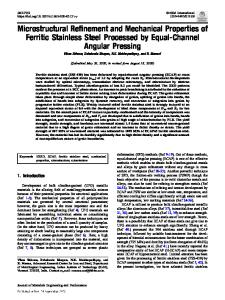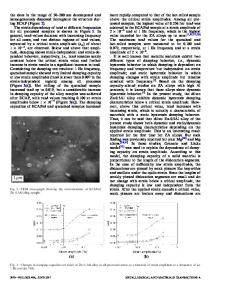Bulk nanocrystalline stainless steel fabricated by equal channel angular pressing
- PDF / 284,567 Bytes
- 6 Pages / 585 x 783 pts Page_size
- 103 Downloads / 330 Views
Y.L. Gao and G. Yang Central Iron and Steel Research Institute, Beijing 100081, People’s Republic of China
S.D. Wu,b) G.Y. Li, and S.X. Li Shenyang National Laboratory for Materials Science, Institute of Metal Research, Chinese Academy of Sciences, Shenyang 110016, People’s Republic of China (Received 26 September 2005; accepted 5 January 2006)
Bulk fully nanocrystalline grain structures were successfully obtained in ultralow carbon stainless steel by means of equal channel angular pressing at room temperature. Transmission electron microscopy (TEM) and high-resolution TEM investigations indicated that two types of nanostructures were formed: nanocrystalline strain-induced martensite (body-centered cubic structure) with a mean grain size of 74 nm and nanocrystalline austenite (face-centered cubic structure) with a size of 31 nm characterized by dense deformation twins. The results about the formation of fully nanocrystalline grain structures in stainless steel suggested that a low stacking fault energy is exceptionally profitable for producing nanocrystalline materials by equal channel angular pressing.
I. INTRODUCTION
Nanocrystalline (nc) metals and alloys, conventionally defined as polycrystals with grain sizes less than 100 nm, have exhibited superior mechanical properties, such as excellent superplasticity and high strength.1–3 During the last two decades, many severe plastic deformation (SPD) methods were developed for producing nanostructured materials.4,5 Of these SPD methods, the equal channel angular pressing (ECAP) technique is the most promising due to its ability to process bulk materials in three dimensions.4 However, the grain sizes obtained by ECAP for many materials are actually outside the nc regime, i.e., on the order of several hundred nanometers (commonly referred to as the ultrafine-grained range). Table I presents several typical materials processed by ECAP. As shown, the finest grain size, typically of the order of ∼200 nm, is obtained in relatively soft materials, such as Cu,6 Al alloys,7 Fe,8 low carbon steel,9 and Ti.10 For hard materials, such as Ti–6Al–4V12 and W,13 even at high temperature, only subgrains with a size of submicrometer are formed. It has been shown that these materials were refined via dislocation-controlled grain subdivision Address all correspondence to these authors. a) e-mail: [email protected] b) e-mail: [email protected] DOI: 10.1557/JMR.2006.0214 J. Mater. Res., Vol. 21, No. 7, Jul 2006
http://journals.cambridge.org
Downloaded: 15 Mar 2015
mechanism and cannot be refined down to nanometers by ECAP at room temperature (RT), especially for those materials with relatively high stacking fault energy (SFE).6–9 However, for materials with low SFE, the plastic deformation mode may change from dislocation slip to deformation twinning, and this is very important for grain refinement. The mechanism of deformation twins leading to both grain subdivision and a martensite transformation was identified in AISI 304 stainless steel during surface mechanical attrition treatment
Data Loading...











